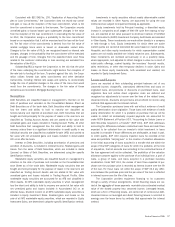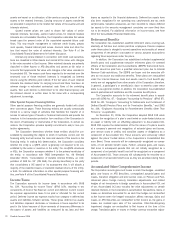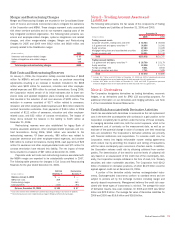Bank of America 2006 Annual Report Download - page 115
Download and view the complete annual report
Please find page 115 of the 2006 Bank of America annual report below. You can navigate through the pages in the report by either clicking on the pages listed below, or by using the keyword search tool below to find specific information within the annual report.
Merger and Restructuring Charges
Merger and Restructuring Charges are recorded in the Consolidated State-
ment of Income and include incremental costs to integrate the operations
of the Corporation and MBNA. These charges represent costs associated
with these one-time activities and do not represent ongoing costs of the
fully integrated combined organization. The following table presents sev-
erance and employee-related charges, systems integrations and related
charges, and other merger-related charges. Merger and Restructuring
Charges for 2005 and 2004 were $412 million and $618 million and
primarily related to the FleetBoston merger.
(Dollars in millions) 2006
Severance and employee-related charges
$85
Systems integrations and related charges
552
Other
168
Total merger and restructuring charges
$805
Exit Costs and Restructuring Reserves
On January 1, 2006, the Corporation initially recorded liabilities of $468
million for MBNA’s exit and termination costs as purchase accounting
adjustments resulting in an increase in Goodwill. Included in the $468
million were $409 million for severance, relocation and other employee-
related expenses and $59 million for contract terminations. During 2006,
the Corporation revised certain of its initial estimates due to lower sev-
erance costs and updated integration plans including site consolidations
that resulted in the reduction of exit cost reserves of $199 million. This
reduction in reserves consisted of $177 million related to severance,
relocation and other employee-related expenses and $22 million related to
contract termination estimates. Cash payments of $144 million in 2006
consisted of $111 million of severance, relocation and other employee-
related costs, and $33 million of contract terminations. The impact of
these items reduced the balance in the liability to $125 million at
December 31, 2006.
Restructuring reserves were also established for legacy Bank of
America associate severance, other employee-related expenses and con-
tract terminations. During 2006, $160 million was recorded to the
restructuring reserves. Of these amounts, $80 million was related to
associate severance and other employee-related expenses, and another
$80 million to contract terminations. During 2006, cash payments of $22
million for severance and other employee-related costs and $71 million for
contract termination have reduced this liability. The net impact of these
items resulted in a balance of $67 million at December 31, 2006.
Payments under exit costs and restructuring reserves associated with
the MBNA merger are expected to be substantially completed in 2007.
The following table presents the changes in Exit Costs and Restructuring
Reserves for the year ended December 31, 2006.
(Dollars in millions)
Exit Cost
Reserves
(1)
Restructuring
Reserves
(2)
Balance, January 1, 2006
$—
$—
MBNA exit costs
269
—
Restructuring charges
—
160
Cash payments
(144)
(93)
Balance, December 31, 2006
$ 125
$67
(1) Exit costs reserves were established in purchase accounting resulting in an increase in Goodwill.
(2) Restructuring reserves were established by a charge to Merger and Restructuring Charges.
Note 3 – Trading Account Assets and
Liabilities
The following table presents the fair values of the components of Trading
Account Assets and Liabilities at December 31, 2006 and 2005.
December 31
(Dollars in millions) 2006 2005
Trading account assets
Corporate securities, trading loans and other
$ 53,923
$ 46,554
U.S. government and agency securities
(1)
36,656
31,091
Equity securities
27,103
31,029
Mortgage trading loans and asset-backed securities
15,449
12,290
Foreign sovereign debt
19,921
10,743
Total
$153,052
$131,707
Trading account liabilities
U.S. government and agency securities
(2)
$ 26,760
$ 23,179
Equity securities
23,908
11,371
Foreign sovereign debt
9,261
8,915
Corporate securities and other
7,741
7,425
Total
$ 67,670
$ 50,890
(1) Includes $22.7 billion and $20.9 billion at December 31, 2006 and 2005 of government-sponsored
enterprise obligations that are not backed by the full faith and credit of the U.S. government.
(2) Includes $2.2 billion and $1.4 billion at December 31, 2006 and 2005 of government-sponsored
enterprise obligations that are not backed by the full faith and credit of the U.S. government.
Note 4 – Derivatives
The Corporation designates derivatives as trading derivatives, economic
hedges, or as derivatives used for SFAS 133 accounting purposes. For
additional information on our derivatives and hedging activities, see Note
1 of the Consolidated Financial Statements.
Credit Risk Associated with Derivative Activities
Credit risk associated with derivatives is measured as the net replacement
cost in the event the counterparties with contracts in a gain position to the
Corporation completely fail to perform under the terms of those contracts.
In managing derivative credit risk, both the current exposure, which is the
replacement cost of contracts on the measurement date, as well as an
estimate of the potential change in value of contracts over their remaining
lives are considered. The Corporation’s derivative activities are primarily
with financial institutions and corporations. To minimize credit risk, the
Corporation enters into legally enforceable master netting agreements
which reduce risk by permitting the closeout and netting of transactions
with the same counterparty upon occurrence of certain events. In addition,
the Corporation reduces credit risk by obtaining collateral from counter-
parties. The determination of the need for and the levels of collateral will
vary based on an assessment of the credit risk of the counterparty. Gen-
erally, the Corporation accepts collateral in the form of cash, U.S. Treasury
securities and other marketable securities. The Corporation held $24.2
billion of collateral on derivative positions, of which $14.9 billion could be
applied against credit risk at December 31, 2006.
A portion of the derivative activity involves exchange-traded instru-
ments. Exchange-traded instruments conform to standard terms and are
subject to policies set by the exchange involved, including margin and
security deposit requirements. Management believes the credit risk asso-
ciated with these types of instruments is minimal. The average fair value
of Derivative Assets, less cash collateral, for 2006 and 2005 was $24.2
billion and $25.9 billion. The average fair value of Derivative Liabilities for
2006 and 2005 was $16.6 billion and $16.8 billion.
Bank of America 2006
113
























